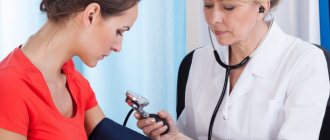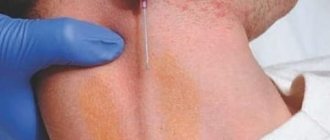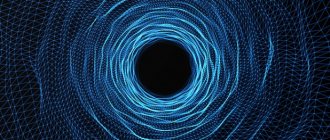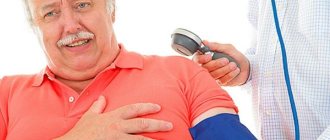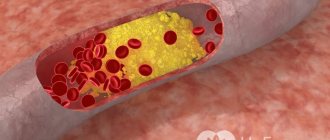Hypertensive macroangiopathy {amp}#8211; causes, symptoms and treatment
Angiopathy refers to the destruction of blood vessels in various diseases.
Angiopathy – translated from Latin means destruction of blood vessels. Vessels are affected by various diseases, as a result of which their work is disrupted and destruction occurs.
This process occurs anywhere in the human body. Vessels of all sizes are destroyed, from the smallest - capillary, to the largest. Another name for the disease is vasopathy.
If vascular angiopathy develops over a long period of time, it leads to irreversible damage to the patient’s health. Organs suffer due to lack of blood supply.
The result is necrosis of the tissue that was fed by the diseased blood vessel. Pathological changes occur in the veins and arteries, plaques and blood clots appear.
During an examination and thorough diagnosis, the doctor determines the type of vasopathy and prescribes treatment. It is impossible to completely eliminate the disease, but properly selected treatment will stop the development of the disease and improve the functioning of blood vessels.
Hypertensive macroangiopathy: what is it? In order to understand the issue, you must first understand what hypertension and angiopathy are. After all, these concepts are interconnected.
Hypertension is a disease of the 21st century. Until relatively recently, 100-200 years ago, hypertension has accompanied humans for decades. Now she kills for 5-7 years. This happens for many reasons - poor nutrition, unhealthy environment, sedentary lifestyle, constant state of stress.
Angiopathy is a pathology in which the walls of blood vessels from constant overload thin and become fragile, which leads to their rupture, and then to hemorrhage. Vascular angiopathy can occur in any organ of the human body, causing a corresponding disease.
Angiopathy is divided into 2 types based on the size of the lesion:
- Macroangiopathy is characteristic of large vessels in the heart, this is the so-called atherosclerosis of the coronary arteries, it occurs in the lower extremities.
- Microangiopathy affects small organs, eyes, kidneys and causes necrosis.
Microangiopathy occurs earlier than macroangiopathy, since the destruction of small vessels occurs much faster than large ones. If a person has developed atherosclerosis of the coronary arteries, then he begins to face not just the danger of developing necrosis in any organ, but sudden, unexpected death.
With persistently high pressure inside the vessels, cracks appear in the walls, in which the formation of cholesterol plaque then begins.
This formation, growing and increasing in size, can completely block the internal lumen of the vessel, thereby stopping the blood flow.
There are a number of reasons why macroangiopathy develops in the body:
- Development of diabetes mellitus.
- Advanced age.
- Increased intracranial pressure.
- Cigarette abuse.
- Various blood diseases.
- Physical damage to blood vessels.
- Osteochondrosis disease.
- Hard physical labor.
- Poisoning the body with harmful substances.
- Weakening of the body's immunity.
Poor circulation in the legs
- blood flow in the legs is disrupted;
- the person experiences severe pain in the lower extremities;
- legs constantly swell;
- a person begins to limp on one leg or the other;
- Gangrene may develop.
Signs of hypertensive macroangiopathy that affects the vessels supplying the brain are as follows:
- memory deteriorates sharply;
- frequent, persistent headache;
- temporary disturbances in coordination of movements;
- paresis.
Atherosclerosis of the coronary arteries leads to coronary heart disease. In this case, a person feels the following manifestations of the disease:
- dyspnea;
- chest pain;
- pain piercing through the chest, often such sensations occur after physical activity;
- The main manifestation of ischemic disease is myocardial infarction.
If macroangiopathy affects a person’s kidneys, then he will have an imbalance of minerals in the blood, swelling will appear, and electrolyte metabolism will be disrupted.
Diagnosis of hypertensive macroangiopathy is a complex and complex process. To begin with, the patient undergoes a primary examination, which includes:
- General blood analysis.
- Blood pressure measurement.
- Ultrasound examination of the affected organ.
MRI
To obtain a complete picture of the vascular system and its functioning, magnetic resonance imaging is performed.
Heart rhythms are measured using electrocardiography.
With the help of echocardiography, the picture of the processes occurring in the heart is clarified.
The diagnosis must be extremely accurate. This is necessary to prescribe adequate treatment.
Treatment of hypertensive macroangiopathy is aimed primarily at normalizing blood pressure. This alone will reduce the likelihood of developing dangerous complications. Also during treatment, attention is paid to the composition of the blood (fat level, viscosity, thickness). Complex therapy not only helps to eliminate the manifestations of hypertensive macroangiopathy and microangiopathy, but also to find out and treat the very cause of the development of these pathologies.
In order to achieve the goals, the doctor prescribes the patient a course of anticoagulants, which thin the blood.
Antispasmodics will dilate blood vessels and relieve pain. Angioprotectors will heal cracks in the walls of blood vessels and strengthen them. For patients with diabetes, the correct level of insulin in the blood is set.
Non-traditional methods of treating hypertensive macroangiopathy include mud baths, acupuncture, and magnetic therapy. The patient is prescribed a strict diet that excludes fatty and fried foods from his diet, because during treatment it is necessary to reduce the level of cholesterol in the blood.
Acupuncture for hypertension
To prevent the disease from developing, you should follow several rules to keep your blood pressure under control:
- The diet should be rich in fresh fruits and vegetables, dairy products and fish. You should not eat fried or fatty foods. You should limit your salt intake.
- It is necessary to get rid of bad habits (drinking alcohol and smoking cigarettes).
- The mental state must be stable; for this you need to avoid stressful situations and follow a daily routine. If necessary, the doctor will prescribe a mild sleeping pill.
- For people leading a sedentary lifestyle, physical therapy, long walks, light jogging or swimming are recommended.
- Even if a person does not have diabetes, it is necessary to regularly check the blood sugar level and its general condition.
In order to diagnose a developing disease in its infancy, which gives a good prognosis for its treatment, it is necessary to regularly undergo a complete medical examination.
This must be done at least once a year. And then the body will be healthy for many years.
With a regular increase in blood pressure in a person, irreversible changes occur in the structure of medium and large vessels - hypertensive macroangiopathy. With sudden changes in blood pressure, damage to the vascular walls occurs, the size of the vessels changes and their functions are disrupted. The disease affects the blood channels of the heart and lower extremities.
The hypertensive form of macroangiopathy includes pathological processes that appear as a consequence of the development of the disease - hypertension. The disease presents irreversible vascular changes. With a constant increase in blood pressure, the pressure on the walls of the blood channels increases. In the process of damage to blood vessels, their diameter decreases, the walls become thinner and become fragile.
At the site of a microcrack in the choroid, excess organic substances, calcium, and microbodies accumulate, and an atherosclerotic plaque is formed. The linear movement of blood changes to a vortex. Such pathological changes lead to rupture of the walls of the blood canal and hemorrhage. The precursor of macroangiopathy at the initial stage of the disease is microangiopathy. With microangiopathy, damage and destruction of small vessels occurs in the early stages of the disease.
In the area of formation of an atherosclerotic plaque, a blood clot can form - a thrombus. When a closed circulatory system is blocked by a blood clot, a heart attack or stroke develops.
Main causes of the disease:
- The cause of the disease can be a frequent increase in intracranial pressure.
lack of pancreatic hormone insulin in the body;
Diagnostic procedures include:
- External examination and blood pressure measurement.
- Biochemical and detailed analysis of blood and urine.
- X-ray method for examining the urinary tract.
- Ultrasound examination of brain vessels, heart arteries, kidneys.
- Echocardiography, electrocardiogram to study cardiac activity and heart contractions.
- Magnetic resonance imaging of blood vessels.
- Analysis of the effects of therapeutic therapy on the body.
Hypertension and angiopathy
Angiopathy is a group of diseases associated with vascular damage due to increased nervous excitability of cells and neurons. Angiopathy is characterized by spasm and paresis of blood vessels, which contributes to increased permeability of the walls and frequent hemorrhage.
There are several types of angiopathy, it all depends on the size of the affected vessels and their condition.
- Hypertensive macroangiopathy, developing as a result of atherosclerotic lesions. With this disease, the patient’s condition is not the best; its severe course complicates it.
- Microangiopathy occurs as a result of necrosis, thrombosis, hyalinosis and fibrinoid swelling. With the development of this disease, damage to the eye vessels and capillaries of the kidneys is observed.
Hypertension is a condition in which a person's blood pressure increases. There is an increase in pressure on the walls of the inner choroid and a decrease in its diameter. Hypertension is called the main disease of the 21st century. It develops rapidly and leads to death within 5 years. The causes of hypertension include poor nutrition, bad habits, ecology, and stress.
Etiology
The main causes of angiopathy of any type include:
- elderly age;
- severe form of diabetes mellitus;
- features of the anatomical structure of blood vessels;
- autoimmune diseases;
- hazardous work conditions, toxins and radiation;
- blood poisoning;
- metabolic disease;
- smoking and alcohol;
- excess body weight;
- lack of moderate physical activity in the patient’s daily life;
- eating over-salted food;
- various injuries;
- lack of certain nutrients or minerals in the body;
- intoxication of the body.
Treatment methods
Macroangiopathy is treated with pharmaceutical medications. For patients with this diagnosis, doctors prescribe medications that are aimed at lowering blood pressure.
Before starting treatment, it is necessary to find out the type of macroangiopathy. It is important to understand what disease led to this complication. After all, you first need to try to get rid of the cause of the pathological process, and only then fight it yourself.
The disease, which is expressed in the form of damage to blood vessels, is quite specific. Therefore, you should trust his treatment to experienced specialists. It is worth noting that therapy for macroangiopathy involves the use of laser technologies. Only modern clinics have such equipment. They can undergo diagnostics and receive an individual prescription. It will indicate those medications that are ideal for a particular patient.
Hypertensive macroangiopathy {amp}#8211; causes, symptoms and treatment
Patients who experience symptoms of this disease, in most cases, fall victim to the following risk factors:
- weakening of the body due to old age;
- arterial hypertension;
- hereditary chronic diseases;
- smoking;
- diabetes;
- addiction to alcoholic drinks;
- abnormalities in the functioning of the vessels of the lower extremities;
- increased intracranial pressure;
- bad ecology;
- diseases of the circulatory system;
- damage to the cervical spine;
- nervous disorders;
- acute intoxication of the body.
Regardless of the reasons that provoked the development of the disease, the clinical picture in most patients will be the same. There are complaints of circles or lightning before the eyes, decreased visual acuity, astigmatism, and so on. In rare cases, when intracranial pressure increases significantly, patients complain of frequent nosebleeds. In such a situation, the primary diagnosis is made by a general practitioner, and all further treatment is carried out by an ophthalmologist.
Damage to the retina of both eyes requires several specialized studies to accurately determine the root cause of the disease:
- Ultrasound scanning of blood vessels allows us to identify hypertensive pathology;
- study of the strength of vessel walls;
- blood flow velocity study;
- radiography allows us to draw a conclusion about the patency of blood vessels;
- MRI provides information about the condition and structure of soft tissues.
High blood pressure can cause vascular angiopathy
Since angiopathy is considered a secondary disease, it often occurs after complications of some other inflammations and pathologies. As a separate, independent disease, it almost never occurs. It occurs rarely, in 10–12% of cases.
Main reasons:
- diabetes
- elevated blood pressure
- high intracranial pressure
- osteochondrosis
- arthritis
- autoimmune inflammation
- lupus
- hypothermia
- spinal and head injuries
- circulatory disorder
- hereditary vascular pathologies
- blood diseases – leukemia, polycythemia, thrombocytosis
Risk factors:
- age from 55 years
- smoking
- drinking alcohol
- atherosclerosis
- obesity
- individual peculiarities of vascular development
- lack of exercise
- lack of vitamins and minerals in the body
After making an accurate diagnosis, the doctor prescribes adequate complex therapy. Such treatment includes the constant use of drugs that lower blood pressure and reduce the risk of complications. The treatment complex consists of taking medications, physiotherapy and traditional medicine. The therapeutic complex includes:
- drugs to lower blood pressure and improve blood circulation;
- antispasmodics;
- anticholesterol drugs;
- medications that interfere with blood clots and thin the blood;
- angioprotectors and microstimulation correctors;
- insulin therapy;
- herbal natural remedies that calm the nervous system;
- intravenous laser irradiation of blood;
- acupuncture;
- plasmacytopheresis;
- mud treatment;
- therapy using a magnetic field on the body;
- a diet rich in dairy products and fish;
- vegetable and fruit juices, sbiten, green tea.
The use of traditional medicine is an effective method in the fight against various manifestations of the disease. Natural plant components help strengthen the walls of blood vessels, cleanse internal organs, reduce blood pressure, and relieve nervous tension during hypertensive attacks. Regular consumption of natural juices, fruit drinks, compotes, as well as products that lower pressure in blood vessels, helps to improve the health of all organs and the body as a whole.
To prevent macroangiopathy and hypertension, it is recommended to constantly monitor the level of pressure in the arteries, reduce body weight if you are overweight, limit the consumption of fatty, fried and salty foods, alcohol, and avoid physical stress and nervous situations. It is necessary to replace a sedentary lifestyle with long walks, it is recommended to go to the pool.
To prevent the disease, undergo a full medical examination once a year, do a biochemical blood test, and monitor blood glucose levels. It is necessary to undergo medical therapy at early signs of the disease in order to stop its development and protect the body from subsequent life-threatening complications.
The information on the site is provided for general information purposes only. We recommend that you consult your doctor for further advice and treatment.
Other reasons
Hypertensive macroangiopathy (what it is, we described above) occurs for many additional reasons:
- due to diabetes;
- due to age;
- with high intracranial pressure;
- as a result of blood diseases;
- due to injuries and osteochondrosis;
- as a result of harmful working conditions;
- from poisoning or intoxication;
- with weakened immunity;
- under the influence of ecology.
Macroangiopathy of the hypertensive type is the main symptom or sign of a disease such as hypertension.
Varieties
There are several types of this disease (depending on the cause of progression and location of the lesion):
- diabetic;
- hypertensive;
- angiopathy of the lower and upper extremities;
- retina;
- hypotonic;
- cerebral (brain);
- arterial (heart);
- traumatic;
- youthful.
Medical statistics are such that most often patients are diagnosed with the diabetic form of the disease (this is due to the prevalence of diabetes mellitus). Angiopathy of the lower extremities also often develops against the background of diabetes. With this type of disease, thickening of the walls of blood vessels and narrowing of the lumen of the arteries in the legs are observed.
These processes together constitute favorable conditions for the progression of atherosclerosis. Diabetic angiopathy can affect not only the vessels of the lower extremities. It negatively affects the functioning of the kidneys, retina, and heart. If this type of disease is not treated for a long time, it can lead to serious consequences, the saddest of which is disability.
Diabetic angiopathy of retinal vessels
The causes of hypertensive angiopathy include: genetic predisposition, excessive consumption of alcoholic beverages, and hypertension. High blood pressure adversely affects blood circulation, as well as the functioning of internal organs and systems in general.
Vascular angiopathy - symptoms, dangers, manifestations, diagnosis
Increasingly, doctors are diagnosing patients with vascular angiopathy. What kind of pathology is, how to recognize it and why it is dangerous is described further in the text.
What kind of pathology is this
Vascular angiopathy (VA), otherwise called vasopathy, is a vascular disease caused by disruptions in nervous regulation. APS is manifested by an increase in the tone of capillaries, veins, and arteries. Manifests itself in acute and chronic forms. It is dangerous due to its negative impact on all parts of the body.
Vasopathy develops against the background of various disorders that arise. This is characterized by disruptions in the activity of blood vessels and subsequent destruction of their walls.
Types and classification
Doctors classify angiopathy according to the disease that provokes the development of APS into several types.
- Hypertensive appearance. Diabetes mellitus is diagnosed against the background of the patient's existing hypertension.
- Diabetic-hypertensive type. The patient's existing diabetes is further complicated by developing hypertension.
- Diabetic look. In diabetics, it manifests itself as a violation of homeostasis, injury to the walls of arteries and veins, as well as generalized vascular damage.
- Hypotonic or arterial appearance. Low blood pressure causes blood clots.
- Eales disease, otherwise called retinal periphlebitis, juvenile or juvenile angiopathy. Inflammation of the ocular vessels and hemorrhage in the retina manifests itself. Angiopathy in adolescents is observed at the age of 14-19 years. At the same time, young people go to medical institutions with a diagnosis of APS 3 times more often than girls.
- Traumatic appearance. This kind of APS occurs when the retina of the eye is injured.
- Alzheimer's disease, otherwise called cerebral or amyloid angiopathy. It is characterized by the accumulation of beta-amyloid protein in the blood vessels of the brain.
APS is also conventionally divided according to the degree of damage:
- microangiopathy – pathology of capillaries;
- macroangiopathy – pathology of arteries and veins.
Causes
There are many causes of angiopathy. Below are the most common factors in the development of this disease.
- diabetes;
- pathologies of the endocrine and vascular system;
- sepsis;
- various intoxications;
- rheumatism;
- hypovitaminosis;
- physical inactivity;
- harmful working conditions;
- obesity;
- bad habits;
- excessive salt consumption;
- age 55+.
To prescribe effective treatment, it is first necessary to find the root cause of the disease.
After all, fighting solely against the consequences is fraught with the progression of the disease and its periodic relapses.
Development mechanism and localization
The occurrence and development of vasopathy is provoked by the following disorders.
- Problems with the nervous regulation of the tone of arteries and veins. Characterized by insufficient functionality of the nervous system tone. In this case, impulses are transmitted rather weakly. For this reason, the activity of arteries and veins decreases. Next, a spasm develops, and this entails a disruption of blood flow.
- Hormonal problems. Excessive synthesis of adrenaline, cortisol, aldosterone, renin and angiothesin-2 is fraught with disruption of the normal functioning of blood vessels.
- Infectious lesion. One of the complications after suffering from vasculitis or phlebitis may be the destruction of two or more vessels.
Angiopathy is localized in several areas of the body.
- retina - affected by Alzheimer's disease, as well as juvenile APS;
- lower extremities - develops against the background of diabetes;
- kidneys;
- brain - occurs in Alzheimer's disease;
- heart - provoked by arterial vasopathy.
Possible complications
APS is a rather dangerous disease, complications from which depend on the location of the lesions.
| No. | Localization area | Possible complications |
| 1 | Heart | Heart attack |
| 2 | Brain | Stroke |
| 3 | Eyes | Loss of vision. |
| 4 | Lower limbs | Gangrene or necrosis |
| 5 | Arteries and veins of the abdominal cavity | Heavy bleeding |
| 6 | Kidneys | Serious problems with filtration. |
Lack of treatment leads to disability or death. To avoid consequences, it is recommended to contact a medical facility.
Manifestation
Main symptoms of vasopathy:
- deterioration of vision, up to its complete loss;
- itching in the legs;
- lameness when walking;
- memory losses;
- decreased attention span;
- problems with orientation (typical of cerebral vascular angiopathy);
- exfoliation of the skin of the upper and lower extremities;
- mirages and visions.
Signs of APS are also directly related to its type.
Thus, hypertensive angiopathy in the early stages can be recognized solely by a slight deterioration in vision, as well as by the appearance of spots in front of the eyes. Unfortunately, this type of vasopathy can only be cured at this stage.
Over time, as the disease progresses, other symptoms will begin to appear:
- hemorrhages in the eyes;
- an increase in the size of the fundus vessels;
- decrease in visual acuity (up to its complete loss);
- constant headaches;
- coughing up blood;
- blood in the stool;
- weather dependence;
- a significant decrease in stress resistance, a constant feeling of anxiety.
Signs of diabetic APS, otherwise called angiopathy of the lower extremities.
- The formation of practically painless trophic ulcers on the legs (mainly on the feet), which over time spread to the muscles and bones, causing necrosis.
- Kidney damage.
- Nervous disorders.
- Decreased visual acuity.
Arterial vasopathy is manifested by disruptions in cardiac activity.
Risk group
The following categories of citizens are at risk of developing vasopathy:
- diabetics;
- persons suffering from hypertension;
- people of retirement age;
- young people aged 14 to 19 years;
- lovers of too salty foods;
- people leading a sedentary lifestyle.
If primary signs of angiopathy are detected, a visit to a hematologist or vascular surgeon is required. Timely therapy will help avoid worsening the condition.
The material was prepared specifically for the website venaprof.ru, edited by pharmacist M.N. Aleksandrova.
Source: https://venaprof.ru/angiopatiya-sosudov/
Diagnostics
Diagnosis of each type of angiopathy should be carried out by highly qualified specialists. First, the doctor conducts a detailed examination and interview of the patient, listens to his complaints. After the initial examination, the person is prescribed the following instrumental diagnostic techniques:
- radiography (both with and without contrast);
- Ultrasound;
- Whole body MRI;
- ophthalmochromoscopy;
- angiography;
- CT;
- examination by an ophthalmologist.
MRI is one of the methods for diagnosing vascular angiopathy
Diagnosis of all types of angiopathy is carried out by a doctor of the highest category. He examines the patient and writes down complaints.
Then the patient is prescribed to undergo tests: X-ray, ultrasound, magnetic resonance imaging, angiography, computed tomography, Doppler, ophthalmochromoscopy, and a thorough examination by an ophthalmologist.
Detection of vascular pathology and organ changes are indications for urgent treatment. Selected individually. The symptoms and type of angiopathy are taken into account.
Important
All treatment methods are important in the fight against a detected disease. Only a variety of medications that change blood pressure and reduce the likelihood of blood clots will help you cope with hypertensive macroangiopathy, the signs of which we listed above.
Only if the whole body is treated can the disease be overcome. An important condition is an integrated approach. If high blood pressure is observed along with an altered blood chemical composition, then the entire treatment plan is adjusted and complex treatment regimens are prescribed.
To identify the disease at an early stage of its development, you need to undergo a complete examination of the body at least twice a year by all specialists. Early treatment gives a good chance of a complete recovery for the patient.
Thousands of men and women come to see doctors with complaints about the poor condition of their blood vessels. Diseases that cause such a disorder are extremely dangerous for humans. They not only worsen the quality of life, but can also be fatal. Many patients who are concerned about the condition of their own blood vessels are diagnosed with a disease such as macroangiopathy. Knowledge about this pathology will be useful for people who care about their health.
Unconventional therapeutic methods
Based on all the information collected, the ophthalmologist makes a diagnosis and prescribes treatment. It should be based on drugs that improve blood circulation in the vessels of the eyeball, for example, Vazonit, Arbifles, Emoxipin, etc. Each of these drugs normalizes the condition of the blood vessels of the brain, and also helps improve blood flow in the capillaries. Some patients are prescribed the drug Calcium dobesilate, which helps increase the strength of the walls of blood vessels.
Certain symptoms require a non-standard approach from the doctor, combining drug therapy with some physical procedures, for example, acupuncture, laser irradiation, and magnetotherapy. Such treatment is allowed to be prescribed only in the complete absence of medical contraindications. The maximum course of such therapy ranges from 14 to 25 days.
When a patient has hypertensive angiopathy, the doctor must do everything possible to normalize blood pressure. At the next stage, it is necessary to reduce the level of cholesterol in the patient’s blood. No less of a problem is diabetic angiopathy, which requires the patient to follow a diet, i.e., completely exclude from the diet foods containing high amounts of carbohydrates.
Pathology of the vessels of the lower extremities must be treated only comprehensively. In addition to traditional medications, angiopathy is treated with folk remedies:
- Dill seeds;
- fresh parsley juice;
- collecting the herbal part of blue cornflower;
- tea based on black currant leaves;
- tincture of rowan fruits;
- tinctures based on caraway seeds.
Treatment with folk remedies for this disease is often prescribed by a doctor, which has a completely scientific explanation. If with other diseases various unofficial methods can do more harm than good, then with angiopathy the use of herbal remedies can speed up recovery. If a patient is diagnosed with macroangiopathy, then restorative therapy is indicated.
It is based on herbal infusions that have a positive effect on individual organs or systems of the body in which the doctor has diagnosed abnormalities. Experience shows that the use of herbal infusions for 20-30 days can reduce the risk of further development of angiopathy several times.
The drug Trental is used in the treatment of vascular angiopathy
Angiopathy is considered a difficult to treat disease. Temporary treatment only improves the condition of diseased vessels, without completely relieving the patient of the problem. Therefore, angiopathy is treated constantly, following the recommendations of doctors.
Therapy includes medication, physiotherapy and, in difficult cases, surgery.
Treatment with medications is varied and also depends on the type of angiopathy.
Hypertension is treated with vasodilators and diuretics. They lower blood pressure and cholesterol.
For diabetics, in addition to the above-mentioned medications, a diet that excludes carbohydrate foods is prescribed. Physical exercise plays an important role. They improve the functioning of the cardiovascular system and the patient’s condition.
To support eye health, the ophthalmologist prescribes:
- Taufon
- Okyuwait
- Lutein
- Anthocyanin
Physiotherapeutic procedures consist of laser treatment, acupuncture, electrotherapy, and mud baths.
Surgical operations are performed in emergency, severe cases, to reduce pressure on the arteries and eliminate the source of inflammation. Operations include:
- limb amputation
- removal of sympathetic nodes
- replacement of blood vessels with prostheses
Cause-and-effect relationships
With hypertensive macroangiopathy, the vessels change their structure and physical properties. With this disease, their appearance, function and structure are modified. The vascular walls are damaged and, as a result, their diameter changes. Macroangiopathy often develops together with microangiopathy. This occurs due to rapid damage to small vessels at an early stage of the disease. In a particularly severe case, hypertensive macroangiopathy of the vessels of the neck and brain is observed, which leads to early heart attacks and strokes.
In hypertensive diseases, a persistent increase in blood pressure is observed. The diameter of the vessel decreases, and greater blood pressure is exerted on the walls.
With a sharp increase, the vessels are damaged from the inside. In the place where the membrane is damaged, blood cells, lipids, and calcium accumulate, which leads to the formation of atherosclerotic plaques or blood clots. As a result, the lumen of the vessels disappears, they do not change their diameter, and the blood flow becomes vortex rather than linear.
Hypertensive macroangiopathy with the formation of arterial deformations is associated precisely with the formation of plaques, which create the risk of vascular rupture and blood clots. These blood clots can break off and clog blood vessels. As a result, myocardial infarction or stroke occurs.
In hypertension, macroangiopathy is inevitable, which determines the clinical manifestation of this disease.
Basic information about the disease
It is no secret that today many people are extremely concerned about the condition of their own blood vessels. And this is not just like that, because many people die from diseases associated with them. In this article, let's look at what vascular macroangiopathy is. This knowledge will be useful to absolutely everyone. What happens when it occurs? There is a systematic destruction of blood vessels. In addition, they change their functions.
Formation of atherosclerotic plaques
Depending on the degree of damage, the disease can be divided into macroangiopathy and microangiopathy. In the first case, it is mainly the limbs that are affected, maybe even the vessels of the heart. But in the second case something less significant is implied. In particular, the capillaries of the eyes are damaged. Naturally, one cannot fail to note the formation of atherosclerotic plaques in the body. This is due to the serious concentration of substances in the body. Mostly calcium and excess fat.
Identification of the disease
The diagnostic process is a comprehensive examination of the patient’s body. This includes blood tests and reactions to treatment, and recording blood pressure numbers. After a detailed examination, it is established that these are signs of hypertensive macroangiopathy, and not another disease.
In case of damage to the vessels of the brain or neck, MRI and ultrasound examination are additionally prescribed. The work of the heart and the state of the vascular system can be studied by ECG, echocardiography, and coronary angiography. The condition of the kidneys is determined by ultrasound and urography.
An important stage of diagnosis is monitoring changes in blood vessels. Correct diagnosis and adequate assessment of existing disorders are the key to prescribing competent treatment. The result largely depends on the diagnosis.
Preventive measures
You can protect yourself from such a disease - just listen to the following advice and follow them unquestioningly.
- The diet should include vegetables, fruits, fish and dairy products. We exclude fatty and fried foods. Salt is also an enemy, so it is necessary to reduce its amount.
- Bad habits are bad for your health. Alcohol and smoking are prohibited.
- The patient must monitor his mental state, avoid stress, depression, and be sure to follow the correct daily routine. At the request of the patient, the attending physician may prescribe sleeping pills or sedatives.
- If you have a sedentary lifestyle, you need to walk in the fresh air more often, engage in light sports: swimming, walking, physical therapy.
- Even if you don't have diabetes, it's a good idea to check your blood sugar levels daily.
Symptoms
The clinical picture depends on the form, severity of the pathological process and its localization.
Signs of angiopathy of the lower extremities:
- cold skin;
- pale or cyanotic skin tone;
- the occurrence of hematomas and altered capillaries for no apparent reason;
- the appearance of areas with altered pigmentation and peeling;
- poor healing of even superficial injuries, despite treatment;
- numbness, itching, burning and crawling sensation in the lower extremities;
- decreased sensitivity in the legs;
- weakening of arterial pulsation;
- pain in the lower extremities, which manifests itself while walking, intermittent claudication.
Angiopathy of the lower extremities, which developed against the background of diabetes mellitus, is characterized by the early addition of signs of nervous system disorders that are associated with lesions of small blood vessels, combination with damage to the eyes and kidneys, as well as the formation of trophic ulcers (in severe cases, gangrene) of the lower extremities against the background preserved pulsation of peripheral arteries. The infectious process can develop against the background of minor injuries, cracks in the skin. Small, almost painless ulcers appear on the lower extremities (most often on the feet), which gradually spread to the muscles and bones. As the pathological process progresses, necrosis occurs, which gradually spreads beyond the ulcers throughout the entire foot, and the so-called diabetic foot develops.
Hypertensive retinal angiopathy in the early stages is asymptomatic or has mild symptoms. Patients experience a slight decrease in visual acuity, the appearance of glare, flashes, lines and/or dots before the eyes.
As hypertensive angiopathy progresses, the following are noted:
- frequent hemorrhages in the eye;
- dilation of fundus veins;
- significant decrease in visual acuity (up to blindness);
- narrowing of visual fields;
- regular headaches;
- frequent nosebleeds;
- hemoptysis;
- detection of blood impurities in urine and feces;
- increased irritability, emotional instability, anxiety;
- attention and memory disorders;
- weather dependence.
Changes in blood vessels are reversible when blood pressure is normalized.
Angiopathy of cerebral vessels is manifested, first of all, by persistent headaches, possible disturbance of orientation in space, and hallucinations.
With arterial angiopathy, cardiac dysfunction and thrombus formation are observed.
Treatment methods
Macroangiopathy is difficult to treat because it is accompanied by irreversible consequences. Therefore, the main goal of treatment is to stop the progression of the disease and prevent complications that can cause disability and even death.
Main goals of therapy:
- Stabilization of biochemical blood parameters, for example, glucose, cholesterol.
- Elimination of hemocoagulation disorders.
- Normalization of blood pressure.
Timely treatment will keep you healthy
To solve these problems, medications are prescribed. The exact list of drugs is determined depending on the type of pathology, the degree of its development and other factors. The following medications may be used:
- Drugs that lower blood sugar if the diabetic form of macroangiopathy is detected.
- Tablets that normalize blood pressure. These are ACE inhibitors, diuretics, beta blockers.
- Drugs that thin the blood. They are needed to prevent blood clots.
- Statins, fibrates, if there are fat metabolism disorders.
Thus, macroangiopathy is a serious disease that leads to irreversible consequences in the vessels and tissues feeding from them. For successful therapy, timely detection and treatment of pathology is important.

